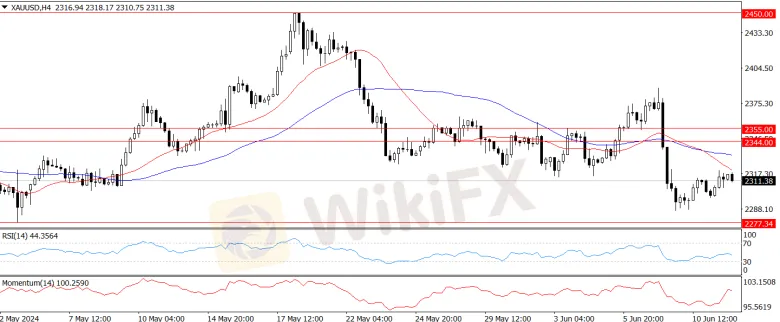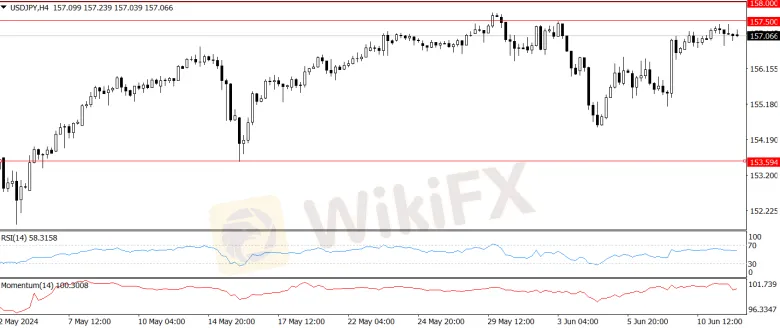简体中文
繁體中文
English
Pусский
日本語
ภาษาไทย
Tiếng Việt
Bahasa Indonesia
Español
हिन्दी
Filippiiniläinen
Français
Deutsch
Português
Türkçe
한국어
العربية
Today's analysis: The Federal Reserve's interest rate decision is approaching, putting downward pressure on gold prices.
Abstract:The Federal Reserve is expected to keep interest rates unchanged, which could support the US dollar and pressure gold prices if a hawkish stance is taken. Gold prices continue to decline after breaking an upward wedge pattern, with a key support level at $2250. The 14-day RSI indicates further potential decline unless prices recover above the 50-day and 21-day moving averages.
Product: XAU/USD
Prediction: Decrease
Fundamental Analysis:
The Federal Reserve will announce its interest rate decision today during the U.S. trading session. Market participants currently expect the Federal Reserve to keep interest rates unchanged, with federal funds futures showing a 99% chance of this happening. If Federal Reserve policymakers take a hawkish stance, meaning they suggest that interest rates may need to stay high for a longer period, it could overturn the current market expectation of a rate cut at the November meeting. This could support the U.S. dollar and push down precious metal prices.
Technical Analysis:
Gold prices have continued to fall after breaking below an upward wedge pattern. If they decisively drop below the May 3 low of $2277, there is a high chance they will fall further. The next support level for gold is at the psychological level of $2250. The 14-day RSI is below 50, currently around 44, indicating that gold prices may continue to decline. Any recovery in gold prices would need to break above the 50-day moving average at $2344. After that, reclaiming the 21-day moving average at $2355 would be crucial to remove the recent bearish trend.

Product: EUR/USD
Prediction:Decrease
Fundamental Analysis:
The three major U.S. stock indexes market opened lower. The U.S. dollar strengthened, while the euro weakened, making it the second worst-performing major currency. Over the weekend, far-right opponents won most of the votes in the European Parliament elections in France, leading Macron to announce elections on Monday. The possibility of the French Parliament being led by the far-right could draw attention to France's poor financial situation, which might shake the EUR. We believe that French politics is another reason the EUR will remain low for a long time.
Technical Analysis:
The EUR/USD pair is at risk of falling further. The daily chart shows the pair keeps trading below all its moving averages, with a flat 200-period SMA providing dynamic resistance in the $1.0790 price zone. At the same time, the 20 SMA turned lower, in line with the increased selling interest, remaining above the 100 and 200 SMA. So far, the 4-hour chart shows an increase in the downward trend. The next support level on the downside is $1.0719. The next resistance level is $1.0804, which is the 200-period SMA.

Product:USD/JPY
Prediction: Increase
Fundamental Analysis:
The USD/JPY rose quickly to $157.23. With interest rate decisions from both the Federal Reserve and the Bank of Japan coming up, a hawkish economic forecast from the FOMC might push the currency policy in favour of the U.S. dollar. Analysts note that USD/JPY is nearing a key bullish breakout level. The GDP report for the first quarter of 2024 shows that Japan's exports fell by 5.1% compared to the previous quarter. Even though the USD/JPY surpassed $150 in the first quarter, exports remain weak. However, the weakening yen might increase speculation that the Bank of Japan will raise interest rates to boost the yen.
Technical Analysis:
The USD/JPY has steadily broken through the 50-day and 200-day EMAs, confirming a bullish trend. If USD/JPY breaks above $157.5, it could move back to the $158 level. If it reaches $158, the bulls might aim for the April 29 high of $160.209. On the other hand, if USD/JPY falls below $156, the bears might act around the 50-day moving average. Breaking below the 50-day moving average would make the $151.685 support level possible. The 14-day RSI is at 57, suggesting that USD/JPY could climb to the April 29 high of 160.209 before entering the overbought zone.

Product: US Oil
Prediction: Decrease
Fundamental Analysis:
US Oil prices have stayed strong in recent trading sessions because investors are optimistic about demand due to the summer vacation season in the Northern Hemisphere. However, uncertainty about the upcoming May CPI data from the world's largest and second-largest economies has limited oil price increases. Investors are closely watching Chinas annual CPI data, which is expected to have grown steadily by 0.3%.
Technical Analysis:
WTI oil prices have bounced back by almost 7.5% from recent lows near $72.50 per barrel. However, the upward movement during the day has hit a major resistance at $78.00 per barrel. The long-term upward trend might face a limit soon if the downward trendline stays in place. For prices to reach $80.00, they need to break and stay above the 200-day EMA near $78.90. The RSI is nearly at 70, which means the market might soon be overbought.

Market Analysis Disclaimer:
The market analysis provided by KVB Prime Limited is for informational purposes only and should not be construed as investment advice or a recommendation to buy or sell any financial instrument. Trading forex and other financial markets involves significant risk, and past performance is not indicative of future results.
KVB Prime Limited does not guarantee the accuracy, completeness, or timeliness of the information provided in the market analysis. The content is subject to change without notice and may not always reflect the most current market developments or conditions.
Clients and readers are solely responsible for their own investment decisions and should seek independent financial advice from qualified professionals before making any trading or investment decisions. KVB Prime Limited shall not be liable for any losses, damages, or other liabilities arising from the use of or reliance on the market analysis provided.
By accessing or using the market analysis provided by KVB Prime Limited, clients and readers acknowledge and agree to the terms of this disclaimer.
RISK WARNING IN TRADING
Transactions via margin involve products that use leverage mechanisms, carry high risks, and are certainly not suitable for all investors. THERE IS NO GUARANTEE OF PROFIT on your investment, so be wary of those who guarantee profits in trading. You are advised not to use funds if you are not prepared to incur losses. Before deciding to trade, ensure that you understand the risks involved and also consider your experience.
Disclaimer:
The views in this article only represent the author's personal views, and do not constitute investment advice on this platform. This platform does not guarantee the accuracy, completeness and timeliness of the information in the article, and will not be liable for any loss caused by the use of or reliance on the information in the article.
Read more

Will Gold Shine Brighter in 2025?
Gold is poised for significant gains in 2025, with experts predicting its price to climb between US$2,900 and US$3,000 per ounce or potentially higher. Analysts attribute this optimistic outlook to sustained gold purchases by central banks, ongoing geopolitical tensions, declining global interest rates, and persistent economic uncertainties. These factors, coupled with gold’s status as a hedge against inflation, underline the precious metal’s appeal in volatile times.

Exness Lowers XAUUSD Spreads by 10% for Better Gold Trading
Exness reduces XAUUSD spreads by 10%, offering professional traders, investors, and analysts improved gold trading conditions with lower costs and better reliability.

KVB Market Analysis | 30 August: JPY Strengthens Against USD Amid Strong Q2 GDP and BoJ Rate Hike Speculation
The Japanese Yen (JPY) strengthened against the US Dollar (USD) on Thursday, boosted by stronger-than-expected Q2 GDP growth in Japan, raising hopes for a BoJ rate hike. Despite this, the USD/JPY pair found support from higher US Treasury yields, though gains may be capped by expectations of a Fed rate cut in September.

KVB Market Analysis | 29 August: Gold Price Recovers as Market Eyes US Rate Cuts and Geopolitical Tensions
Gold prices (XAU/USD) rebounded on Thursday after dipping below $2,500 per ounce. Expectations of US interest rate cuts and ongoing political and geopolitical tensions are boosting demand for gold, as lower rates reduce the opportunity cost of holding the non-yielding metal.
WikiFX Broker
Latest News
The Withdrawal Trap: How Scam Brokers Lure Victims into Paying More
FCA to Investors: Think Twice Before Trusting These Brokers
Trump\s tariffs: How could they affect the UK and your money
Trump gambles it all on global tariffs he\s wanted for decades
TradingView Brings Live Market Charts to Telegram Users with New Mini App
Trump tariffs: How will India navigate a world on the brink of a trade war?
Interactive Brokers Launches Forecast Contracts in Canada for Market Predictions
Authorities Alert: MAS Impersonation Scam Hits Singapore
IG Group Acquires Freetrade for £160M to Expand UK Investment Market
U.S. March ISM Manufacturing PMI Released
Currency Calculator







